Researchers at the University of Camerino questioned whether there is cross-contamination of dairy milk proteins in soy mylk, when using common practices in the cafe to prepare the milks. The results are surprising and highlight that we need to be careful when preparing and serving alternative mylks and dairy milk in cafes if we are going to protect our customers from allergens.
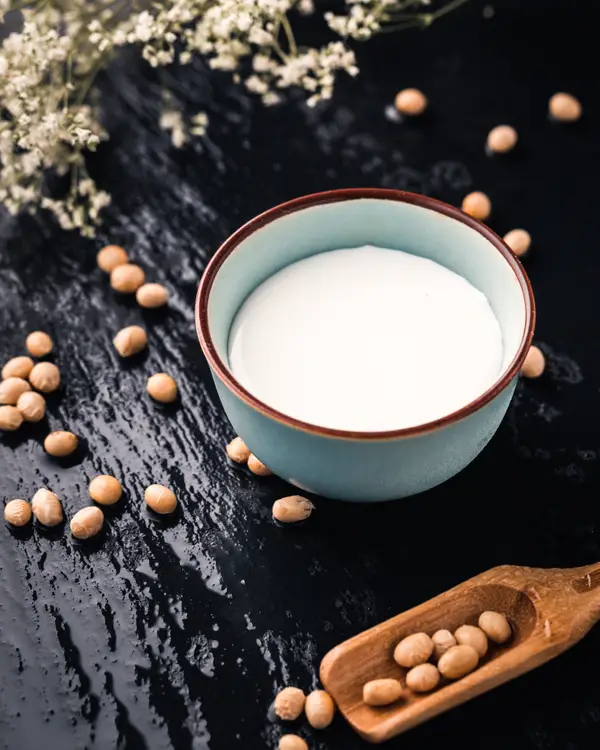
Ethics, the environment, taste preferences and health are all reasons people are moving to drink coffee with alternative mylks. However, for some people, it is not a choice, there is a significant risk of an allergic reaction ffrom drinking dairy milk. In the café, where it is a common practice to use one steam wand and one cloth to steam and clean all “milks”, there is a risk of cross-contamination between the dairy and non-dairy milks. Research conducted as part of a PhD program by Giuseppe Santini has identified that there is cross-contamination of cow milk proteinl from steaming dairy milk to soy mylk when cleaning protocols are not carefully managed.
Whether you are drinking an oat mylk flat white, a soy cappuccino or an almond mylk latte, alternative mylks to add to your coffee are growing in popularity and in options. Plant-based mylks give people suffering from allergies or intolerance, as well as those who follow specific diets, an opportunity to enjoy their coffee with mylk. There are now a large variety of plant-based mylks that can be used for common drinks on the café menu: soy, oat, rice, almond, cashew, coconut and hemp to name a few. Soy milk was in the forefront of the plant-based alternatives to dairy milk on the coffee market and became extremely popular among customers on a global scale.
Milk proteins stabilize foam in espresso-based milk drinks. Due to their amphiphile structure, they play the role of surfactants and adsorb on the surface of air bubbles thus stabilizing them. Plant proteins can also act as surfactants and stabilise foam as milk proteins. Soybeans naturally contain many proteins. This makes it suitable for foaming and frequently producers add a soy base to other plank-based drinks, like oat and rice.
In many coffee shops it is common for a barista to use the same steam nozzle and the same cloth for the preparation of different types of espresso based drinks where both dairy milk and plant-based alternatives are served. Thus, the traces of dairy milk proteins might get into the plant-based drink and cause a serious problem for a person suffering from a cow milk allergy.
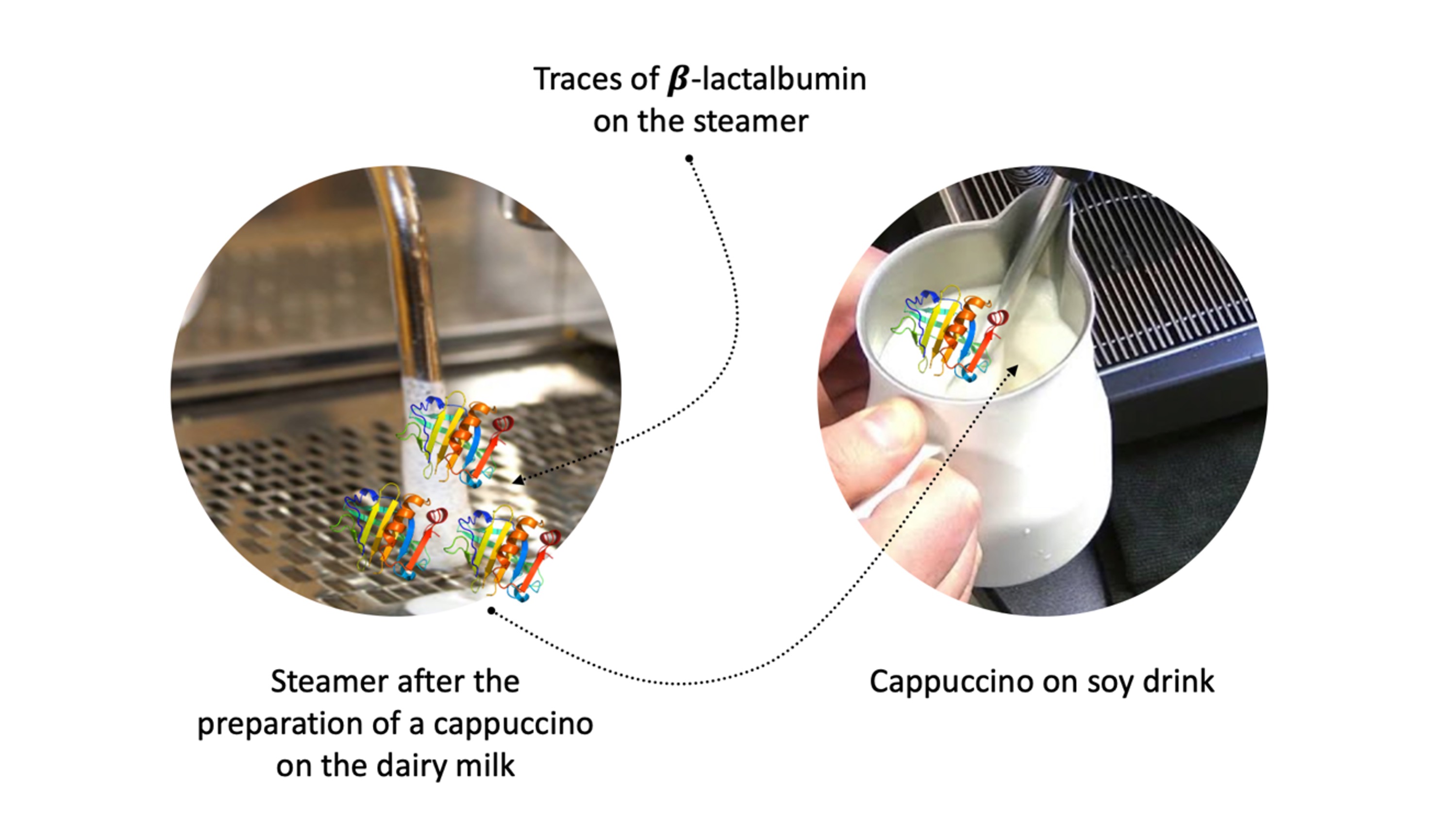
It is important to mention that lactose intolerance and cow milk protein allergy are not the same. Lactose-intolerant people can consume lactose-free dairy milk. Unlike cow milk allergy, intolerance doesn't involve the immune system. In the case of an allergy, the immune system recognises milk proteins as harmful for the organism triggering the production of immunoglobulin E (IgE) antibodies to neutralize the protein (allergen). Those affected by the allergy must totally avoid any dairy products that contain traces of cow milk proteins since the allergy is a life-threatening disease.
Given the risks, in one of our experiments we studied the potential for cross-contamination of soy milk with dairy milk proteins. All cappuccinos were prepared on the same steam wand. We carried out a series of tests trying to replicate the most frequent conditions that may take place in a bar. The steam wand was always cleaned with a microfiber cloth.
Using two separated clean steam nozzles, we prepared two “reference” milk samples: cow milk and soy mylk. Then, we replicated some common coffee shop scenarios by making a cappuccino with dairy milk and a cappuccino with soy mylk using the same steam wand. At each experiment we varied a procedure of the steam wand cleaning. The aim of the experiment was to determine the best procedure to clean the steam wand to avoid the traces of milk proteins in the plant-based alternatives. 3 different tests with 3 samples per test and 4 experimental conditions were completed. Test 3 repeated Test 2 to see if the results could be replicated.
We tested the presence of β-lactoglobulin (the main whey protein in dairy milk and a potential allergen) in the soy-based cappuccinos to check if there are traces of an allergen where it is not supposed to be. To check this, we put a small droplet of the soy-based cappuccino on a sheet of nitrocellulose that contained specific anti-β-lactoglobulin antibodies and, consequently, could bind any potential traces of β-lactoglobulin in the soy-based cappuccino.
Test 1, results:
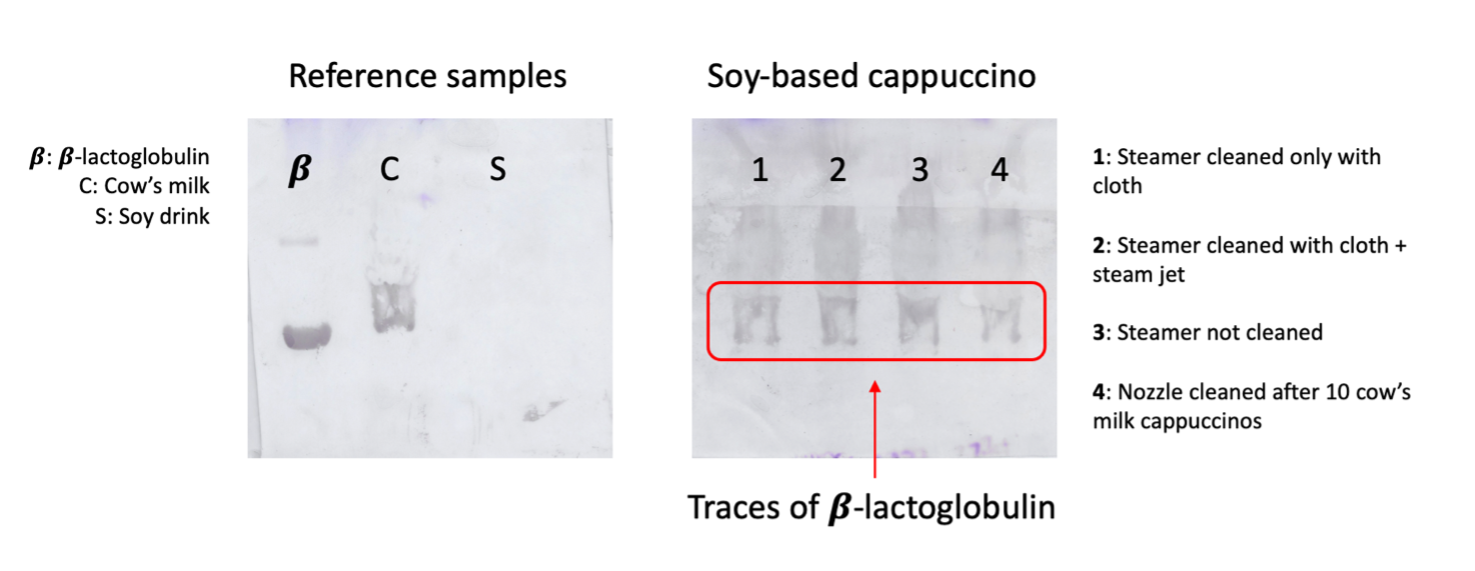
In cases where the steam wand is not properly cleaned all soy-based cappuccinos had traces of β-lactoglobulin:
Test 2, results:
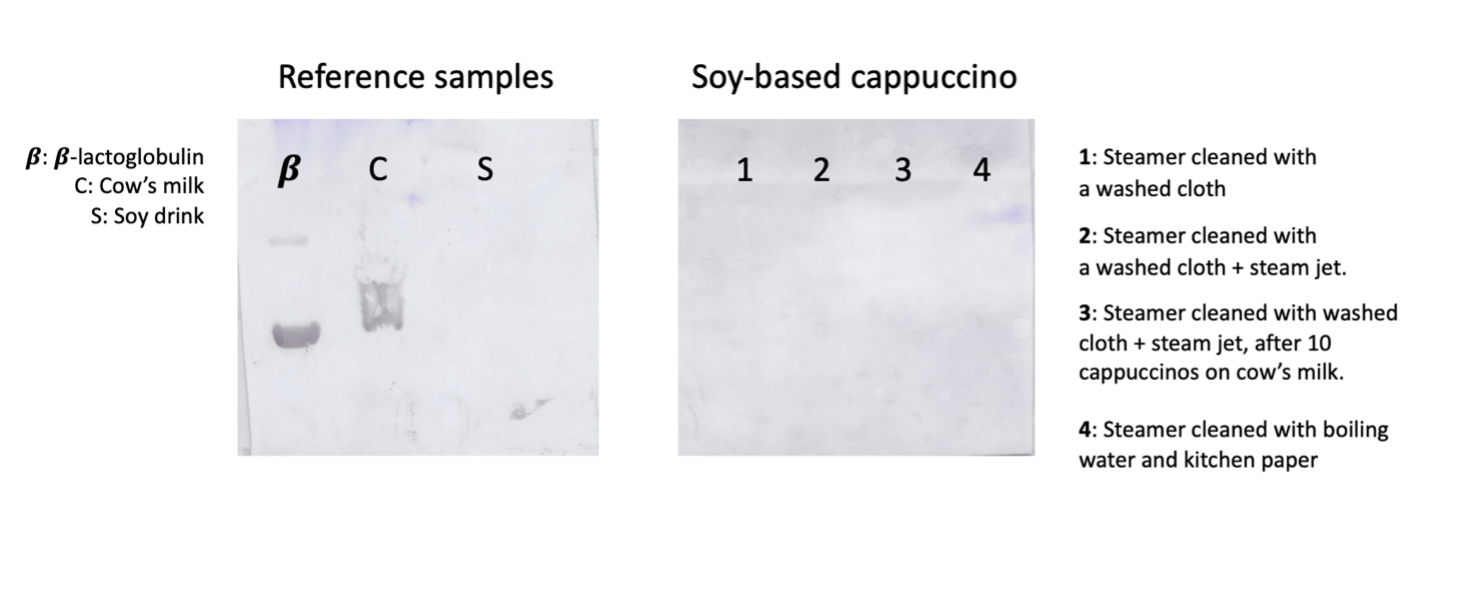
If the steamer is properly cleaned (see the figure below) there are no traces of β-lactoglobulin in the soy-based cappuccino:
Test 3, results:

In the last experiment we decided to repeat some tests to make sure that the results can be replicated. Surprisingly, we found some traces of β-lactoglobulin in one of four cappuccinos with soy. It was even in the sample when the steam wand was cleaned with a clean cloth. We speculate that this could happen because there was some dairy milk left within the steamer, thus the cleaning with the cloth was not enough in this case.
Test 3 shows that there is the high variability in the cappuccino preparation affecting the presence of potential allergens. So, it is relatively hard to assure the customer that the plant-based drink is 100% free from cow milk proteins if a barista uses only one cleaning option.
Since the potential allergens may appear easily in the soy mylk from the dairy milk through the steamer, we believe that the most effective way to clean the steam wand between cappuccinos on different types of “milks” is to activate the steam wand in a pitcher of water, boil the water and then clean it with a paper towel or with a cloth used solely for plant-based drinks. The only way to be 100% sure that the plant-based drink is free from dairy milk proteins is to use a different steamer exclusively for plant-based alternatives. While this experiment only assessed cross contamination of dairy milk proteins in the soy mylk sample, further tests are needed to assess cross-contamination between different plant based mylks. In this case there may be risk with nut allergies, soy or gluten.
For people working in cafés it is worth considering the options for mitigating the risk of cross-contamination from the steam wand. With regards equipment, using different steam wands and cloths for plant based mylks reduces the risk. It is important to know and communicate that where dairy and non-dairy ‘milks’ are steamed on the same wand, there will be a risk of allergens. Training the team about these risks and reinforcing the message of good hygiene and cloth separation is valuable for your customers safety and your peace of mind.
Side note: When is milk a mylk?
The language around dairy and non-dairy milks can be a bit confusing. Dairy or cow milk are interchangeable, but if the milk is from a different animal, like a goat, or a camel, it would be called by the name of the animal, for example, camel milk, not dairy milk. With alternative mylks, such as oat, rice, almond, soy, and hemp, they will be described as an alternative, plant based or non-dairy ‘mylk’. The word milk can then be spelled mylk to avoid misunderstanding that it is a more common cow milk.
Authors::
Giuseppe Santini, Ph.D. student in Life and Health Sciences, School of Biosciences and Veterinary Medicine at the University of Camerino.
Yulia Klimanova, Ph.D. student in Life and Health Sciences, School of Biosciences and Veterinary Medicine at the University of Camerino.
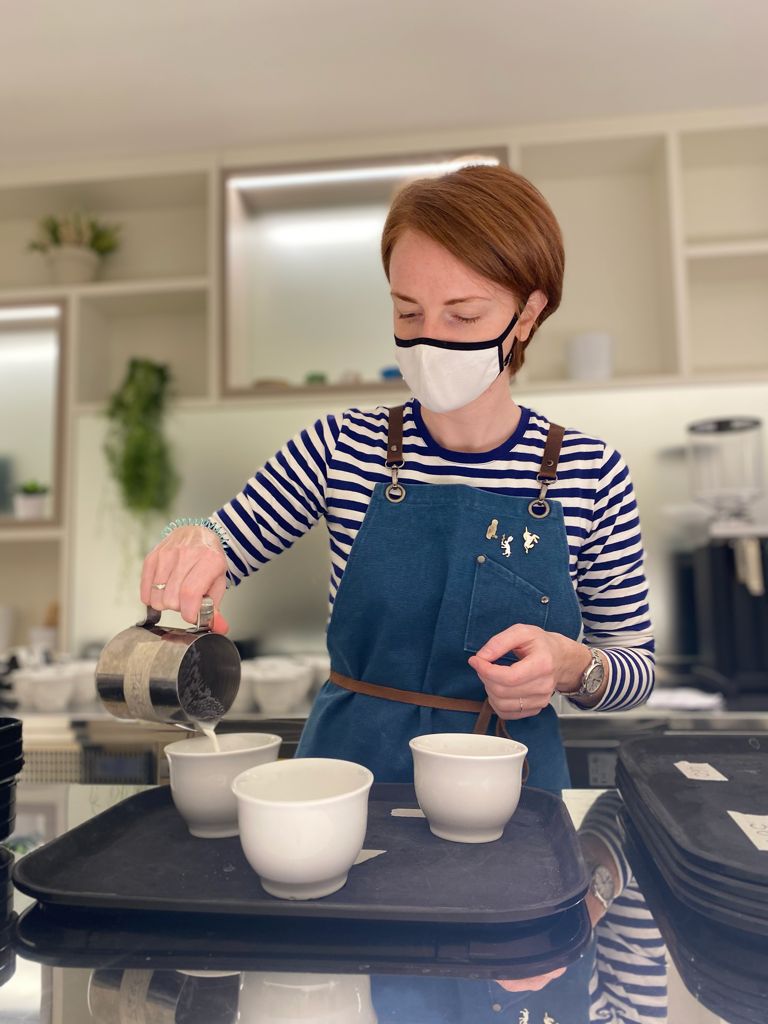
Hochwallner, H., Schulmeister, U., Swoboda, I., Spitzauer, S., & Valenta, R. (2014). Cow’s milk allergy: From allergens to new forms of diagnosis, therapy and prevention. Methods, 66(1), 22–33. doi:10.1016/j.ymeth.2013.08.005
Allen, K. J., Remington, B. C., Baumert, J. L., Crevel, R. W. R., Houben, G. F., Brooke-Taylor, S., … Taylor, S. L. (2014). Allergen reference doses for precautionary labeling (VITAL 2.0): Clinical implications. Journal of Allergy and Clinical Immunology, 133(1), 156–164. doi:10.1016/j.jaci.2013.06.042
Huppertz, T. (2010), Foaming properties of milk: A review of the influence of composition and processing. International Journal of Dairy Technology, 63: 477-488
Become part of a global community of coffee professionals. Access courses and be the first to hear about news, research and events from across the coffee world.
Join now
© 2024 Coffee Knowledge Hub
Simonelli Group SpA
Via Emilio Betti, 1, 62020
Belforte del Chienti MC
P.IVA 01951160439
VAT n. 01951160439
info@coffeeknowledgehub.com

This website utilises cookies to enable necessary site functionality such as logging you in to your account. By remaining on this website you indicate your consent as outlined in our Cookie Policy.